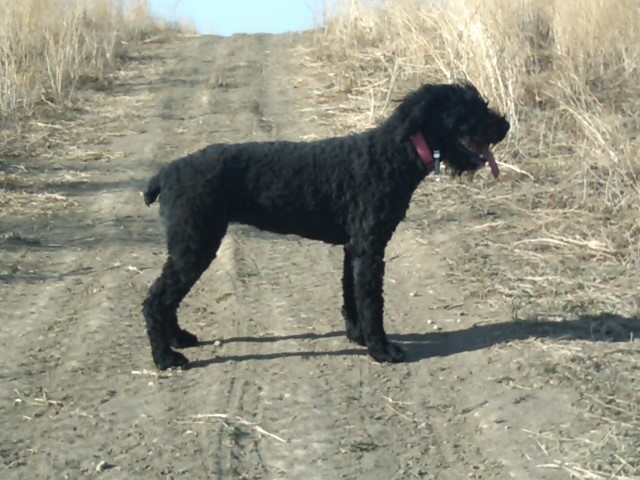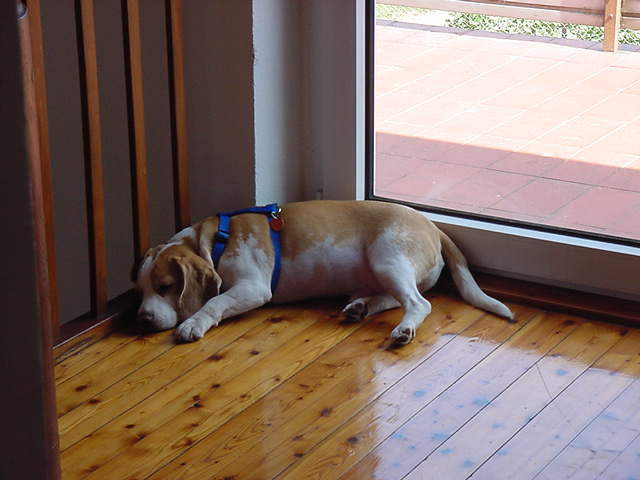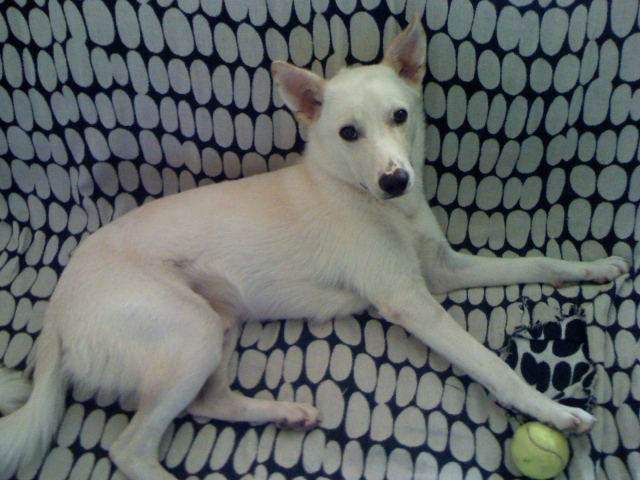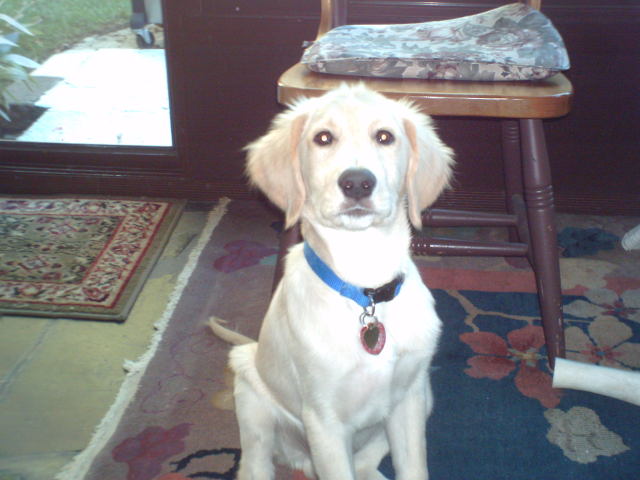QuestionHello
I have a 2 1/2 year old male neutered Boston Terrier named Brutus.
Brutus is very well loved and cherished at home. He get regular exercise either at doggy day camp or on the non camp days 45 min playtime at the dog park. And at least 1 walk a day.
He loves to play with dogs. He loves people but it has to be where he determines the person is trustworthy. Meaning that Brutus cannot be met with over enthusiasm by strangers otherwise he is scared and pulls away.
With us, its fine but not with new people.
The thing is, he really is such a gorgeous/cute dog (I'm not just saying this bc I'm his Mom) that most people get excited to meet him, and thats just not his way.
I tell people they need to ignore him, and in a minute or 2 he will come to them and sniff them out and they will be best friends.
Aside from Brutus's extensive playtime with dogs at either camp or the park, he is loving and affectionate with us at home, loving to lay on the couch with us or in bed with us.
OK heres the problem:
Brutus is sometimes bad with kids.
On occasion Brutus will see a kid and for whatever reason either start barking at them, jumping on them, or even nipping their hand.
But then the very next time he sees a different kid, he can totally ignore them or even sometimes sniff them out.
Its unpredictable.
We do not have kids.
Kids are not around on a daily basis, though Brutus has been around kids enough where he knows they exist.
When there is a kid around and we are in a controlled environment like our home or someone else's home, I always have give the child a treat to put in their hand and allow Brutus to lick it off their hand.
He responds well to that, as he always loves a treat, and that usually will make friends between Bru and the kid.
In places where its not as controlled like the dog park, Brutus can sometimes run up to a kid and either bark at them, jump on them, or on occasion even nip their hand.
These kids quite often are not even realizing Brutus is there until this happens.
He has never hurt anyone, though the nips and the jumps can often scare the child and make them cry.
He sometimes has jumped up on adults at camp that he may not know but usually its more kids. He has never gone up to an adult at the dog park and acted the way he sometimes does with kids.
When he was about 6 mos old (after neutering) Brutus started bullying smaller dogs or newer puppies at the dog park. It was getting obnoxious so I contacted a behaviorist.
The behaviorist determined that Bru was shy and needs confidence built. I did different exercises with him
like "nothing in life is free" type of stuff which worked really well and within weeks he was a different dog at the park. Still playful and friksy but in a nice way.
I have tried and tried with 2 different behaviorists to get Brutus more comfortable around new people who come up to him and want to pet him and kids.
Nothing has ever really worked.
We have spent a good amount of money and time, and have determined that Bru just needs to meet new people his way so he is not scared, which really is not a big deal at all. I just tell them to ignore him and they do, and right away he wants to meet them without them fawning all over him.
The kids thing is still baffling me.
Just when he has been indifferent and/or nice to kids a few different instances, he will all of a sudden act out to another kid.
Most of the kids he does not know, except a small few.
If I am hovering over him at the park, or standing next to the kid he will not do this. He gets the message that I do not like this.
One last thing, Brutus is not a barky dog. Only time he barks is when someone comes to our front door or walks into a place where he is, kind of like a 2 second guard dog.
He barks like a guard dog, and then when the person walks in he stops.
So, this brings me to:
Can anything be done, or is Brutus just a dog that we have to accept needs to be closely monitored around kids?
I'd love your opinion to make some sense of this.
THANKS
Tamara
AnswerYou said: "If I am hovering over him at the park, or standing next to the kid he will not do this. He gets the message that I do not like this."
This is the key. I can't count how many owners have inadvertently either created or exacerbated a fear aggression response in their dog. The actual message he may be getting is quite different from the one you are intending. Two things exacerbate fear aggression (and that is what your dog is demonstrating toward children), those being "correction" and "calming". Scenario one: owner (using choker collar or sharp pull on leash with verbal correction or pseudo growl) "corrects" dog as dog lunges/barks/growls; dog is in fear mode (fight/flight/freeze) and immediately his thought pattern toward the offending object("I don't like you, what are you, go away") is impacted by the anger/bullying (from dog's perspective) of his owner (yanking, choking, angry, saying "no" in growly voice.) Dog's fear is now doubled. He is confused by his conspecific's behavior ("Shouldn't s/he know this is a fearful situation? Why am I being picked on for doing my job?") and the fear increases. There is NO CONNECTION between his fear (which is not a choice, it is a physiological reaction) and his owner's behavior. Second scenario: Dog lunges/barks/growls in fight/flight/freeze mode thinking same as above and reacting automatically to physiological response; owner bends down, pets dog's head or flank, "Oh nooooo nothing to be afraid of, see?" which, of course, is immediately and correctly construed as reward.
It's extremely unfortunate that people take young children to dog parks and dog recreation areas; it's also highly inappropriate, because not all dogs are socialized to children. Children smell different (they have no pheromones yet), they behave differently (higher voices, speech patterns), they are more erratic in physical movements and are generally far less predictable than are adults. Unless a dog has been exposed to children of varying ages from puppyhood and throughout the first two years of life on a fairly consistent basis which has been controlled to be certain no fear develops, it can be quite difficult to attempt to habituate a dog to children. In my opinion, children do not belong in dog play areas, but I'm not in control of these things. So you have a job cut out for you, and this is it:
Take a companion to the dog park with you. Keep Bru on long extending leash or training lead. Ask your companion to observe your dog VERY CLOSELY when a child approaches. As the child approaches, your dog will go toward him/her. YOU turn your BACK on your DOG and go QUICKLY in the opposite direction to the end of the leash (without jerking the dog or changing his direction.) Ask your friend to closely observe what the dog does. If you have contributed anything to this behavior, he will STOP, he will TURN to look at you, and he will either change direction to go toward you or (as John Fisher used to say) "go shopping"...which means, sniff the ground, look around aimlessly, stare up at the sky, etc. Give your friend a code word for this "displacement behavior" if s/he observes it (let's say the code word is GUILT). The moment Bru displaces, companion should say GUILT at which word you turn, call the dog to you, command him to "sit" (whatever word you use for that), praise/reward, go on your merry way until the next child approaches and repeat the above exercise. If YOU are the "guilty" party, within 20 to 30 repetitions of this exercise over the course of two to three weeks should substantially reduce Bru's reaction to approaching children. He SHOULD begin to come toward YOU, sit and wait for praise/treat. If you do not see this development, give it 36 more trials; but you should see the dog reacting quite differently to approaching children (displacing, looking around, looking at you (you should turn your head away, force him to think this out for himself), coming toward you, ignoring the child, etc. Always move CALMLY away from the child when you see the dog is reexperiencing the child's presence, do NOT use the dog's name, do NOT praise, do NOT touch the dog, unless you have given him a command which he has successfully performed. I don't suggest you begin asking any obedience performance from this dog until his fear is clearly, if not altogether extinguished, at least substantially minimized.
Now, given his behaviors toward puppies and smaller dogs, you may very well have been seeing another variation of this same problem. Puppies can develop real antipathy toward neonates and smaller breed dogs based upon mismanagement by their breeder, removal from littermates too soon, or simply no exposure to same other than their own littermates. Additionally, 8 to 10 (approximately) weeks of age is a strong fear response phase in the domestic dog and often odd fears are acquired. NILIF (Nothing In Life is Free) is a behavior modification intended to demote dominance; in fact, what it does is psychologically promote the human; this is most likely why Bru calmed when you were using this device, because he felt you were IN CONTROL and his fight/flight/freeze response extinguished.
Regarding your dog's reaction to adult 'strangers', this is also a strong fear reaction. This dog lacks personal confidence (genetically) but YOU have done a MARVELOUS JOB WITH HIM! Without you, he may very well have become a fear biter. It's best for 'strangers' to totally ignore Brutus (as you have been doing) for the first few minutes, then casually offer a kind word and perhaps even dropping a small tidbit. But let me warn you that merely because a dog takes a treat from someone does NOT mean his next behavior will be coming up the leash to bite: I've seen it happen. Be sure the 'strangers' you allow to interact with Bru are not fearful of dogs and especially of him, as this will set him up to fail. To truly analyze and treat this dog's fear aggression requires in person evaluation; to do otherwise is unethical. I've given you as many tools as I can in this venue.
My further advice is: your description of how Bru will tolerate one kid, then not another, might be the flooding he's experiencing (if there are many children, rather than just a small few, coming toward and around him.) This is a disaster waiting to happen. Even if he rehabilitates to the approach of one child (as described above), a "flood" might very well extinguish any ground you have gained. Although people enter these dog runs and dog parks at their own risk, nothing gets the ire of the authorities like a dog biting a child. In this case, the child is truly innocent (s/he's just walking by or trying to be friendly) and the dog is truly innocent (he's just acting out of a physiological adrenaline rush), but the dog always gets it in the end. There are dog runs and dog parks, I'm sure, where there are not large numbers of children (especially at certain times of the day.) Since I am not available to put hands, and eyes, on this dog, my advice to you has only the "teeth" you give it. I suggest you monitor the child population of the places Bru goes for exercise and that all important interaction with other dogs.

 I was riding my bicycle when my 1yr old Bouvier bit my leg
Question
Pup
Hello, I have a 1yr old intact Bouvier bit
I was riding my bicycle when my 1yr old Bouvier bit my leg
Question
Pup
Hello, I have a 1yr old intact Bouvier bit
 licking the floor not stop
QuestionGeorgie
QUESTION: Hi,
I have a 7 year ol
licking the floor not stop
QuestionGeorgie
QUESTION: Hi,
I have a 7 year ol
 Dog walking problems
Question
Snickers
I have been trying to train my dog SN
Dog walking problems
Question
Snickers
I have been trying to train my dog SN
 my 7 month old golden changed for the worse
QuestionRiley at 6 months
QUESTION: I got a gold
my 7 month old golden changed for the worse
QuestionRiley at 6 months
QUESTION: I got a gold
 uncontrollable beagle
Question
max
My beagle is a year and a half. Ive had hi
uncontrollable beagle
Question
max
My beagle is a year and a half. Ive had hi